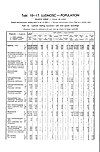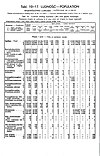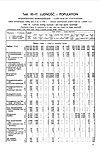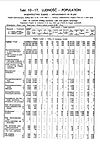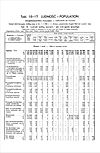1931 Polish census: Difference between revisions
New section for notable conspiracy theories |
→Conspiracy Theories: add missing article |
||
| Line 95: | Line 95: | ||
==Conspiracy Theories== |
==Conspiracy Theories== |
||
After [[World War II]], [[Apolinary Hartglas]], a Polish Jew and member of the Warsaw [[Judenrat]] <ref>Yisrael Gutman, Ina R. Friedman, The Jews of Warsaw, 1939-1943, Indiana University Press, 1989, pg. 17</ref> claimed that [[Edward Szturm de Sztrem]], the pre-war chairman of the Polish census statistical office, admitted that the census returns, particularly those from the south-east, had been altered at executive level.<ref>Apolinary Hartglas, Na pograniczu dwoch swiatow (Tel Aviv, 1950)</ref> Another communist era account alleged that he admitted "that officials had been directed to undercount minorities, especially those in the eastern provinces",<ref name="Blanke">{{cite book|url=http://books.google.com/books?id=80r6Mbnxf8IC&pg=PA95&lpg=PA95&dq=Edward+Szturm+de+Sztrem+census&source=bl&ots=O_JJJ2M5oC&sig=98RkAiV0uwPcjRJQWe-pLS45zfE&hl=en&sa=X&oi=book_result&resnum=6&ct=result|title=Orphans of Versailles: The Germans in Western Poland, 1918-1939|author=Richard Blanke|publisher=[[University Press of Kentucky]]|year=1993 | isbn=978-0-8131-1803-1}}</ref> although the census never had an ethnicity/nationality survey. |
After [[World War II]], [[Apolinary Hartglas]], a Polish Jew and member of the Warsaw [[Judenrat]] <ref>Yisrael Gutman, Ina R. Friedman, The Jews of Warsaw, 1939-1943, Indiana University Press, 1989, pg. 17</ref> claimed that [[Edward Szturm de Sztrem]], the pre-war chairman of the Polish census statistical office, admitted that the census returns, particularly those from the south-east, had been altered at the executive level.<ref>Apolinary Hartglas, Na pograniczu dwoch swiatow (Tel Aviv, 1950)</ref> Another communist era account alleged that he admitted "that officials had been directed to undercount minorities, especially those in the eastern provinces",<ref name="Blanke">{{cite book|url=http://books.google.com/books?id=80r6Mbnxf8IC&pg=PA95&lpg=PA95&dq=Edward+Szturm+de+Sztrem+census&source=bl&ots=O_JJJ2M5oC&sig=98RkAiV0uwPcjRJQWe-pLS45zfE&hl=en&sa=X&oi=book_result&resnum=6&ct=result|title=Orphans of Versailles: The Germans in Western Poland, 1918-1939|author=Richard Blanke|publisher=[[University Press of Kentucky]]|year=1993 | isbn=978-0-8131-1803-1}}</ref> although the census never had an ethnicity/nationality survey. |
||
==References== |
==References== |
||
Revision as of 07:31, 14 October 2015
| Polish census of 1931 | |
|---|---|
| Mother tongue in Poland, based on 1931 census | |
 |
The Polish census of 1931 or Second General Census in Poland (Polish: Drugi Powszechny Spis Ludności) was the second census taken in Poland, performed on December 9, 1931 by the Main Bureau of Statistics.[1] It established that Poland's population amounted to 32 million people (over 5 million more than in the previous census of 1921).
The census was organised following the rules established by an act of the Polish Parliament of October 14, 1931. In contrast to earlier census of 1921, the 1931 census did not count national minorities and detailed information on types of farms, leaving only the question of the overall area of land owned by the citizen.[2] The part related to education was expanded to include questions of ability to read and write.
The results of the census were being published in 39 volumes between 1936 and 1939 in a publishing series "Statistics of Poland". A list of all settlements in Poland was also prepared, but only a part related to Wilno Voivodeship was published.
Results
The population was categorized by mother tongue i.e. the primary language in the following categories: Polish, Ukrainian, Ruthenian (i.e. Rusyn), Belarusian, Russian, Lithuanian, German, Yiddish, Hebrew, Local, Other, and Not Declared. The category "Local" (Polish: tutejszy) versus "Other" (Polish: inny) was hotly debated after the fact, because a number of significant languages were not on the list, e.g., Romani, Armenian, and/or what might constitute transitional language e.g. Polesian, Kashubian and others.[3]

| Population by first language | Population by faith | |
|---|---|---|
|
|
The population was also categorized by religion. Most Jews spoke Yiddish, and some spoke Hebrew. However included with the Jews are 372,000 Polish speakers who are sometimes classified with the Polish group. Included with the Poles are 984,000 Eastern Orthodox & Greek Catholic adherents who are sometimes classified with the Ukrainian and Belarusian groups by those seeking to assign ethnicity based upon religion.[5] Statistical differences existed between Ruthenians and Ukrainians. Ruthenians nationwide were 96.5% Catholic but only 3.2% Orthodox, compared to Ukrainians who were almost equally divided at 52.4% Catholic and 46.6% Orthodox.[4][6]
By cities
-
1931 Census of Poland, Miasto Krakow , table 10 Ludnosc-Population-pg.11
-
1931 Census of Poland, Miasto Lodz, table 10 Ludnosc-Population-pg.14
-
1931 Census of Poland, Miasto Lwow , table 10 Ludnosc-Population-pg.11
-
1931 Census of Poland, Miasto Poznan , table 10 Ludnosc-Population-pg.11
-
1931 Census of Poland, Miasto Warsaw , table 10 Ludnosc-Population-pg.18
-
1931 Census of Poland, Miasto Wilno , table 10 Ludnosc-Population-pg.11
By voivodships
-
1931 Census of Poland, Bialostock Voivodship, table 10 Ludnosc-Population-pg.23
-
1931 Census of Poland, Krakow Voivodship, table 10 Ludnosc-Population-pg.26
-
1931 Census of Poland, Kielce Voivodship, table 10 Ludnosc-Population-pg.28
-
1931 Census of Poland, Lublin Voivodship, table 10 Ludnosc-Population-pg.26
-
1931 Census of Poland, Lodz Voivodship, table 10 Ludnosc-Population-pg.23
-
1931 Census of Poland, Lwow Voivodship, table 10 Ludnosc-Population-pg.32
-
1931 Census of Poland, Nowogrodek Voivodship, table 10 Ludnosc-Population-pg.19
-
1931 Census of Poland, Slaskie Voivodship, table 10 Ludnosc-Population-pg.20
-
1931 Census of Poland, Polesie Voivodship, table 10 Ludnosc-Population-pg.20
-
1931 Census of Poland, Pomorski Voivodship, table 10 Ludnosc-Population-pg.26
-
1931 Census of Poland, Poznan Voivodship, table 10 Ludnosc-Population-pg.32
-
1931 Census of Poland, Stanislaw Voivodship, table 10 Ludnosc-Population-pg.22
-
1931 Census of Poland, Tarnopol Voivodship, table 10 Ludnosc-Population-pg.26
-
1931 Census of Poland, Warsaw Voivodship, table 10 Ludnosc-Population-pg.30
-
1931 Census of Poland, Wilno Voivodship, table 10 Ludnosc-Population-pg.10
-
1931 Census of Poland, Wolyn Voivodship, table 10 Ludnosc-Population-pg.22
Mother Tongue question and criticism
The census used the concept of mother tongue and religion to classify the respondents, rather than nationality. The 1921 census had included a nationality question which was replaced in the 1931 census by the "mother tongue" question; this change was protested by Ukrainians and Jews among others, many of whom were bilingual or trilingual.[7] Moreover, many Jews considered Polish to be their mother tongue.[3]
This situation created a difficulty in establishing the true number of ethnic non-Polish citizens of Poland. Some authors used the language criterion to attempt to establish the actual number of minorities, which was difficult considering that over 707,000 people in Polesia declared that they spoke "local" rather than any other language.[8] Other authors used approximation based on both language and declared religion.[9] After World War II in Soviet bloc countries the interpretation of the census was used for political purposes, to underline the officially-supported thesis that pre-war Poland incorporated areas where the non-Polish population made up the majority of inhabitants. For this purpose some authors combined all non-Polish speakers in South-Eastern Poland (namely Ukrainians, Belarusians, Rusyns, Hutsuls, Lemkos, Boykos and Poleszuks) into one category of "Ruthenians".[10] In fact, the census had counted speakers of Belarusian, Ukrainian, Russian, and Ruthenian languages as separate categories[11]
Some authors contend that the change in questions asked by the census officials was due to the Polish government's wish to minimise the presence of minorities[3][12][13] and represented an attempt to maximize the effects of a decade of educational policies stressing the Polish language.[14] Tadeusz Piotrowski called the 1931 census official but "unreliable" for determining ethnicity, claiming that [by using language as an indicator of ethnicity] it had underestimated the number of ethnic non-Poles, and that in particular, ethnic Poles were not a majority in the Nowogródek Voivodeship and Polesie Voivodeship.[15]
Conspiracy Theories
After World War II, Apolinary Hartglas, a Polish Jew and member of the Warsaw Judenrat [16] claimed that Edward Szturm de Sztrem, the pre-war chairman of the Polish census statistical office, admitted that the census returns, particularly those from the south-east, had been altered at the executive level.[17] Another communist era account alleged that he admitted "that officials had been directed to undercount minorities, especially those in the eastern provinces",[18] although the census never had an ethnicity/nationality survey.
References
- ^ Główny Urząd Statystyczny (corporate author) (1932). Drugi powszechny spis ludności z dnia 9 XII 1931r. Formularze i instrukcje spisowe (in Polish). Warsaw: Główny Urząd Statystyczny. p. 128.
{{cite book}}:|author=has generic name (help) - ^ Council of Ministers of the Republic of Poland (1931). Rozporządzenie Rady Ministrów z dnia 2 września 1931 r. w sprawie przeprowadzenia drugiego powszechnego spisu ludności (PDF) (in Polish). Warsaw. Dz.U. 1931 nr 80 poz. 629.
{{cite book}}: CS1 maint: location missing publisher (link) - ^ a b c Joseph Marcus (1983). Social and Political History of the Jews in Poland, 1919-1939. Walter de Gruyter. p. 17. ISBN 978-90-279-3239-6.
- ^ a b "Główny Urząd Statystyczny Rzeczypospolitej Polskiej, drugi powszechny spis ludności z dn. 9.XII 1931 r. - Mieszkania i gospodarstwa domowe ludność" [Central Statistical Office the Polish Republic, the second census dated 9.XII 1931 - Abodes and household populace] (PDF). Central Stastical office of the Polish Republic. 1938. Archived from the original (PDF, direct download, table: page 30; in Polish) on 2014-03-17.
- ^ U.S. Bureau of the Census The Population of Poland Ed. W. Parker Mauldin; Washington, 1954. [page needed]
- ^ (Polish) Główny Urząd Statystyczny (corporate author) (1932) "Ludnosc, Ludnosc wedlug wyznania i plci oraz jezyka ojczystego" (table 10, pg. 15)
- ^ Celia Stopnicka Heller (1993). On the Edge of Destruction: Jews of Poland Between the Two World Wars. Wayne State University Press. p. 68. ISBN 978-0-8143-2494-3.
- ^ Ben Fowkes (2002). Ethnicity and Ethnic Conflict in the Post-communist World. Macmillan. ISBN 978-0-333-79256-8.
- ^ Jerzy Tomaszewski (1985). Rzeczpospolita wielu narodów (in Polish). Warsaw: Czytelnik. p. 35., as cited in Piotrowski, op.cit., page 294
- ^ Henryk Zieliński (1983). Historia Polski 1914-1939 (in Polish). Wrocław: Ossolineum.
- ^ (Polish) Główny Urząd Statystyczny (corporate author) (1932) "Ludnosc, Ludnosc wedlug wyznania i plci oraz jezyka ojczystego" (table 10, pg. 15)
- ^ Tadeusz Piotrowski (1998). "Belorussian collaboration". Poland's Holocaust: Ethnic Strife, Collaboration with Occupying Forces and Genocide in the Second Republic, 1918-1947. McFarland. p. 294.
{{cite book}}: External link in|chapterurl=|chapterurl=ignored (|chapter-url=suggested) (help) - ^ Philipp Ther; Ana Siljak (2001). Redrawing Nations: Ethnic Cleansing in East-Central Europe, 1944-1948. Rowman & Littlefield. ISBN 978-0-7425-1094-4.
- ^ Ilya Prizel (1998). National identity and foreign policy: nationalism and leadership in Poland. Cambridge University. p. 63. ISBN 978-0-521-57697-0.
- ^ Piotrowski, op.cit., page 143: [The Belarusians] were distributed as follows: Polesie, 654,000; Nowogrodek, 616,000; Wilno, 409,000; Bialystok,269,100
- ^ Yisrael Gutman, Ina R. Friedman, The Jews of Warsaw, 1939-1943, Indiana University Press, 1989, pg. 17
- ^ Apolinary Hartglas, Na pograniczu dwoch swiatow (Tel Aviv, 1950)
- ^ Richard Blanke (1993). Orphans of Versailles: The Germans in Western Poland, 1918-1939. University Press of Kentucky. ISBN 978-0-8131-1803-1.
External links
- Original report from census. Document is in Polish and French. Internet Archive (PDF file direct download, 88 pages).
- The Podlaska Digital Library: document search. Partial results can be found when searching for the following keyword: Spis powszechny 1931 r


